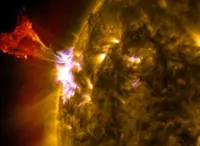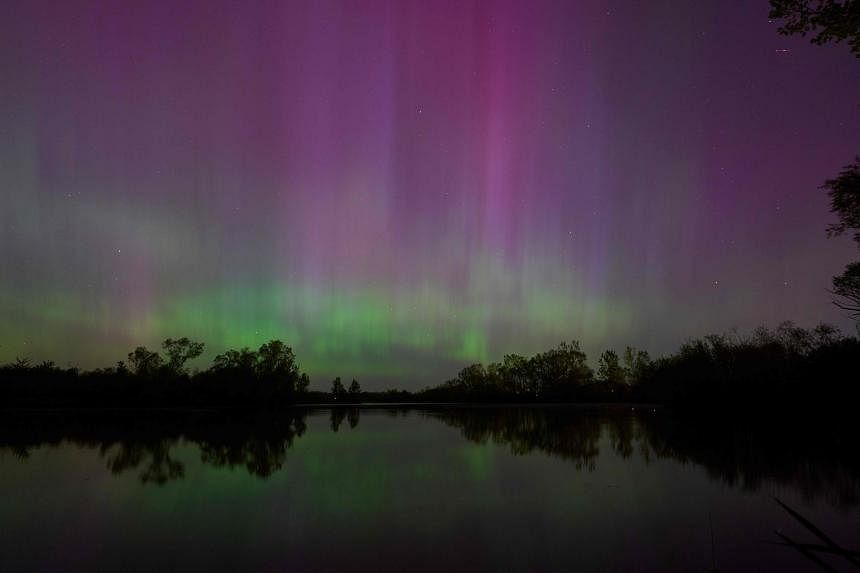An aurora borealis seen during a solar storm over the National Monument of Scotland in Edinburgh, on May 10.- PHOTO: AFP
WASHINGTON (AFP): The most powerful solar storm in more than two decades struck Earth on Friday evening, triggering spectacular celestial light shows from Tasmania to Britain -- and threatening possible disruptions to satellites and power grids as it persists into the weekend.
The first of several coronal mass ejections (CMEs) -- expulsions of plasma and magnetic fields from the Sun -- came just after 1600 GMT, according to the National Oceanic and Atmospheric Administration (NOAA)'s Space Weather Prediction Center.
It was later upgraded to an "extreme" geomagnetic storm -- the first since the "Halloween Storms" of October 2003 caused blackouts in Sweden and damaged power infrastructure in South Africa. More CMEs are expected to pummel the planet in the coming days.
Social media lit up with people posting pictures of auroras from northern Europe and Australasia.
"We've just woken the kids to go watch the Northern Lights in the back garden! Clearly visible with the naked eye," Iain Mansfield in Hertford, England, told AFP.
That sense of wonder was shared in Australia's island state of Tasmania.
"Absolutely biblical skies in Tasmania at 4am this morning. I'm leaving today and knew I could not pass up this opportunity," photographer Sean O' Riordan posted on social media platform X alongside a photo.
Authorities notified satellite operators, airlines and the power grid to take precautionary steps for potential disruptions caused by changes to Earth's magnetic field.
Unlike solar flares, which travel at the speed of light and reach Earth in around eight minutes, CMEs travel at a more sedate pace, with officials putting the current average at 800 kilometers (500 miles) per second.
The CMEs emanated from a massive sunspot cluster that is 17 times wider than our planet. The Sun is approaching the peak of an 11-year cycle that brings heightened activity.
- 'Go outside tonight and look' -
Mathew Owens, a professor of space physics at the University of Reading, told AFP that how far the effects would be felt over the planet's northern and southern latitudes would depend on the storm's final strength.
"Go outside tonight and look would be my advice because if you see the aurora, it's quite a spectacular thing," he said. People with eclipse glasses can also look for the sunspot cluster during the day.
In the United States, this could include places such as Northern California and Alabama, officials said.
NOAA's Brent Gordon encouraged the public to try to capture the night sky with phone cameras even if they couldn't see auroras with their naked eyes.
"Just go out your back door and take a picture with the newer cell phones and you'd be amazed at what you see in that picture versus what you see with your eyes."
- Spacecraft and pigeons -
Fluctuating magnetic fields associated with geomagnetic storms induce currents in long wires, including power lines, which can potentially lead to blackouts. Long pipelines can also become electrified, leading to engineering problems.
Spacecraft are also at risk from high doses of radiation, although the atmosphere prevents this from reaching Earth.
NASA has a dedicated team looking into astronaut safety and can ask astronauts on the International Space Station to move to places within the outpost that are better shielded.
Following one particularly strong flare peak, the US Space Weather Prediction Center said users of high-frequency radio signals "may experience temporary degradation or complete loss of signal on much of the sunlit side of Earth."
Even pigeons and other species that have internal biological compasses could also be affected. Pigeon handlers have noted a reduction in birds coming home during geomagnetic storms, according to NASA's Jet Propulsion Laboratory.
Officials said people should have the normal backup plans in place for power outages, such as having flashlights, batteries and radios at hand.
The most powerful geomagnetic storm in recorded history, known as the Carrington Event after British astronomer Richard Carrington, occurred in September 1859.
Excess currents on telegraph lines at that time caused electrical shocks to technicians and even set some telegraph equipment ablaze. - AFP







